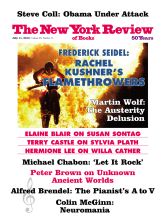In response to:
'Masters of Doing Nothing at All' from the February 7, 2013 issue
To the Editors:
For openers, Pico Iyer declares that the absence of incident in Japanese fiction reflects the uneventfulness of Japanese life—what he is actually identifying is merely reticence—and cites the novelist Natsume Sōseki as a prime example [“‘Masters of Doing Nothing at All,’” NYR, February 7]. “Even the titles of his books,” he writes, “(such as Sorekara, or And Then), often stress the fact of nothing happening.” This is a curiously tendentious interpretation, especially in view of the fact that something does indeed happen, something terrible: the hero, Daisuke, takes his friend’s wife for himself and is left confronting madness as he contemplates the social implications of his actions. And Then was a 1909 sequel to Sōseki’s enduringly popular novel Sanshiro; almost certainly, he intended the title to mean “And here’s what happened next.” In any event, to characterize Sōseki’s novels in particular as blandly deficient in action is to overlook the emotional conflicts that churn beneath their placid surface.
Mr. Iyer asserts that “more modern writers”—Kawabata, Tanizaki, and Mishima—wrote about “how Japan had already lost its integrity and soul to the West,” whereas Sōseki “embraced in his life the central question of the day, which was how his country could combine ‘Japanese spirit, Western technology.’” Here we have a compound misapprehension. First, the canonical novelists Mr. Iyer cites are more recent than Sōseki but hardly “more modern”: the depth and exactitude of character revelation Sōseki achieved in his late novels—Jamesian precisions—qualify him, perhaps uniquely in Japan, as a “modern” novelist in the Western sense of that term. Moreover, no twentieth-century Japanese writer was more poignantly and articulately aware than Sōseki of the paralyzing cost of, in his words, “incurring a culture.” (See, for example, his famous essay “The Civilization of Modern-Day Japan.”) Specifically, he ascribed the isolation and loneliness at the heart of his bleak vision of life to the egoism imported, in his view, as part and parcel of Japan’s undiscriminating imitation of the West.
John Nathan
Takashima Professor of Japanese Cultural Studies
University of California, Santa Barbara
Santa Barbara, California
Pico Iyer replies:
I’ve been a huge admirer of my friend and sometime neighbor John Nathan for almost twenty years now; his command of Japanese and of many things Japanese far outstrips my own. And I’m thrilled he invokes Henry James in his letter; I only wish he’d read my piece with a little more Jamesian attentiveness.
He begins by informing us that uneventfulness is not the same as reticence; I took pains in my article to note that “in Sōseki’s world doing nothing should never be mistaken for feeling too little” and that the central couple’s “silences say plenty.” He informs us that “emotional conflicts” in Sōseki’s novels “churn beneath their placid surface.” I write that in Japan and its literature you’re “living in a realm of detonations, under the surface and between the lines.”
He goes on to tell us that Sōseki is more modern (in a nineteenth-century, Jamesian, “Western sense”) than such later writers as Kawabata, Tanizaki, and Mishima. I’m not sure what exactly “Western” means here: Sōseki is generally associated with Meiji Japan, and the other three with the anxieties that immediately preceded, attended, and followed World War II. All three were alive in the mid-1960s, and dealing with the complications of modern, postwar Japan forty-eight years after Sōseki’s death in 1916. No “depth and exactitude of character revelation” in Tanizaki’s Makioka Sisters or Kawabata’s Snow Country? That might come as a surprise to many.
John ends his piece, having seen Sōseki as modern “in the Western sense,” by citing Sōseki’s celebrated apprehensions about the West. I wonder if a letter of complaint was really necessary?
This Issue
July 11, 2013
A Pianist’s A–V
Hard on Obama
The Unbearable



